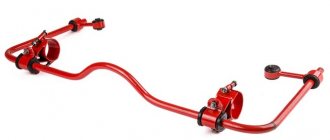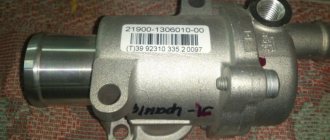Purpose of the thermostat on the VAZ 2106
The thermostat must control the degree of heating of the coolant and react in a timely manner when the antifreeze temperature becomes too high or, conversely, too low.
The thermostat maintains the temperature of the coolant in the engine cooling system in the desired range
The device can direct coolant through either a small or large cooling circle, thereby preventing the engine from overheating, or, conversely, helping it quickly warm up after a long period of inactivity. All this makes the thermostat the most important element of the VAZ 2106 cooling system.
Thermostat location
The thermostat in the VAZ 2106 is located to the right of the engine, where the pipes for discharging coolant from the main radiator are located. To see the thermostat, simply open the hood of the car. The convenient location of this part is a big plus when it becomes necessary to replace it.
To gain access to the VAZ 2106 thermostat, simply open the hood
Principle of operation
As mentioned above, the main task of the thermostat is to maintain the engine temperature within specified limits. When the engine needs to warm up, the thermostat blocks the main radiator until the engine reaches the optimal temperature. This simple measure can significantly extend the life of the engine and reduce wear on its components. The thermostat has a master valve. When the coolant reaches a temperature of 70 °C, the valve opens (it should be noted here that the opening temperature of the main valve can be higher - up to 90 °C, and this depends both on the design of the thermostat and on the thermal filler that is in it used).
Essentially, a thermostat is a regular valve that responds to changes in antifreeze temperature
The second important element of the thermostat is a special compression cylinder made of brass, inside of which there is a small piece of technical wax. When the antifreeze in the system reaches 80 °C, the wax in the cylinder melts. As it expands, it presses on the long rod connected to the main thermostat valve. The rod extends from the cylinder and opens the valve. And when the antifreeze cools, the wax in the cylinder begins to harden, and its expansion coefficient decreases. As a result, the pressure on the rod weakens and the thermostatic valve closes.
By opening the valve here we mean moving its leaf by only 0.1 mm. This is the initial opening value, which consistently increases by 0.1 mm as the antifreeze temperature rises by two to three degrees. When the coolant temperature rises by 20 °C, the thermostat valve opens fully. The full opening temperature can vary from 90 to 102 °C depending on the manufacturer and design of the thermostat.
Fault diagnosis
It turns out that if the engine quickly overheats or its temperature does not reach 80-90 degrees, the thermostat is faulty? You could say this. However, to confirm the symptom it is necessary to conduct a full diagnosis. Below is how they do it.
- Start the engine.
- Feel all the highways. The pump hose must be hot. On the contrary, the pipe that goes to the radiator should be cold.
- After heating the engine to 90 degrees, turn it off, recheck the hoses, as well as the bottom of the radiator. This time all surfaces should be hot as a large cooling loop opens. Replacing the engine thermostat will be required if, as the internal combustion engine warms up, the temperature of the lines coming from the valve is approximately the same.
And of course, if it is not possible to warm up the engine or it takes too long, the valve again needs to be replaced.
Another way to check the device involves removing the thermostat. Then you need to lower it into some container, fill it with cold water and put it on the stove to heat up. As soon as the liquid begins to boil, a working valve should make a loud click, indicating that it is opening. If this does not happen, you need to install a new part.
Types of thermostats
The VAZ 2106 car was produced for many years. And during this time, engineers made a number of changes to it, including thermostats. Let's look at what thermostats were installed on the VAZ 2106 from the release of the first cars to the present day.
Single valve thermostat
Single-valve thermostats were installed on the very first “sixes” that rolled off the VAZ assembly line. The operating principle of this device has been described in detail above. To date, these devices are considered obsolete, and finding them on sale is not so easy.
The first “sixes” were equipped with the simplest, single-valve thermostats
Electronic thermostat
An electronic thermostat is the latest and most advanced modification that replaced single-valve devices. Its main advantages are high accuracy and reliability. Electronic thermostats have two operating modes: automatic and manual.
Electronic thermostats are used in modern cooling systems and differ from their predecessors in high accuracy and much greater reliability
Liquid thermostat
Thermostats are classified not only by design, but also by the type of fillers. Liquid thermostats were the very first to appear. The main component of a liquid thermostat is a small brass cylinder filled with distilled water and alcohol. The operating principle of this device is the same as that of the wax-filled thermostats discussed above.
Solid thermostat
The filler in such thermostats is ceresin. This is a substance similar in consistency to regular wax, which is mixed with copper powder and placed in a copper container. The cylinder has a rubber membrane connected to a rod, also made of dense rubber that is resistant to high temperatures. Ceresin, expanded from heating, presses on the membrane, which, in turn, acts on the rod and valve, ensuring the circulation of antifreeze.
The main element of a solid-fill thermostat is a container with ceresite and copper powder
Which thermostat is better
Today, thermostats based on solid fillers are considered the best option for the VAZ 2106, since they have the optimal combination of price and quality. In addition, they can be found in any auto store, unlike liquid single-valve ones, which are practically no longer on sale.
Features of replacement for Renault Logan 1.6 16 valves
There are no particular differences in replacing the thermostat on 8 and 16 valve Renault Logan engines, the only difficulty is that it is difficult to get to the bottom bolt, because this unit is located in a slightly different place on the 16 valve engine.
There are two ways to solve the problem:
- Remove the engine protection and unscrew the bolt from below;
- Use a special wrench with a flexible connection.
You will also have to dismantle some engine parts.
The rest of the algorithm remains unchanged.
Signs of a broken thermostat
There are a number of signs that clearly indicate that the thermostat is faulty:
- The light on the instrument panel is constantly on, indicating that the engine is overheating. This usually happens because the thermostat valve has closed and is stuck in that position;
- The engine warms up very poorly. This means that the thermostat valve does not close tightly. As a result, antifreeze flows through both the small and large cooling circles and cannot warm up in a timely manner;
- After the engine starts, the lower thermostat tube heats up literally within a minute. You can check this by simply placing your hand on the nozzle. This situation indicates that the thermostat valve is stuck in the fully open position.
If any of these symptoms are detected, the driver should replace the thermostat as soon as possible. If the car owner ignores the above symptoms, this will inevitably lead to overheating of the engine and its jamming. It is extremely difficult to restore an engine after such a breakdown.
Node resource
Note that Logan is equipped with several types of power plants, different in performance characteristics and parameters. But at the same time, all of them use the same water pump, therefore the procedure for replacing it on different types of engines is almost the same, with the exception of some features regarding disassembling the motor for access.
First, let's figure out when this element should be replaced.
The manufacturer recommends performing this operation every time you replace the timing belt, and the drive life is 60 thousand km.
But it has been experimentally established that a water pump can last twice as long, that is, 120 thousand km is not the limit for a pump.
Note that the life of the water pump is also affected by the quality of manufacture.
A cheap part, produced by someone unknown, is unlikely to work for a long time and will quickly fail.
Therefore, it is not necessary to rely on the manufacturer’s recommendations. Of course, if you have extra money, you can change the pump and when replacing the drive belt, it won’t be superfluous. But you don’t have to do this, but during further operation it will be necessary to periodically check the condition of the pump in order to notice its failure in time and replace it.
Functions and operating principle
It is extremely important for a car to remove excess heat that accumulates in the engine. This is what coolant is primarily designed for.
To reduce this very temperature, the cooling system of the “fourteenth” VAZ model includes a thermostat and an electric cooling radiator fan .
Device diagram
The valve, which is responsible for the flow of coolant, is located inside the housing. It, in turn, has three pipes:
- Input – goes to the pump;
- Two outputs - from the radiator and the engine.











